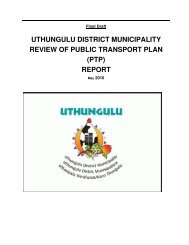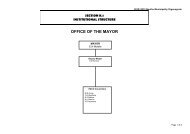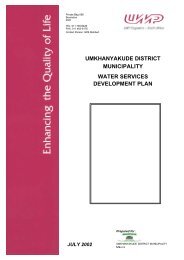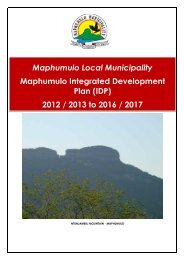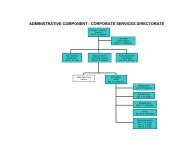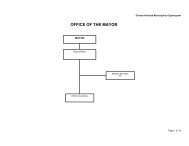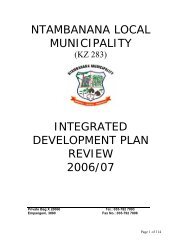Final Adopted IDP - KZN Development Planning
Final Adopted IDP - KZN Development Planning
Final Adopted IDP - KZN Development Planning
Create successful ePaper yourself
Turn your PDF publications into a flip-book with our unique Google optimized e-Paper software.
Provincial Spatial Economic <strong>Development</strong> Strategy<br />
The KwaZulu-Natal Spatial Economic <strong>Development</strong> Strategy (PSEDS) was formulated in<br />
2007 as a spatial economic assessment of the areas of need and potential within the<br />
Province. The PSEDS is intended as a guide to service delivery to achieve the goals set<br />
in ASGI-SA to halve poverty and employment by 2014. The PSEDS is built on the five<br />
principles set out in the NSDP. The PSEDS sets out to focus on where government<br />
directs its investment and development initiatives; capitalises on complementarities and<br />
facilitate consistent and focused decision making; and bring about strategic<br />
coordination, interaction and alignment. The PSEDS recognises that social and economic<br />
development is never uniformly distributed since Apartheid created an unnatural<br />
distortion of development and this distortion must be addressed. Within the<br />
framework of the NSDP, the PSEDS aims to achieve the following:<br />
Eradication of extreme poverty and hunger;<br />
Fighting poverty and protecting vulnerable groups in society;<br />
Promotion of gender equality and empowerment of women;<br />
Developing a comprehensive response to HIV / AIDS, malaria and other diseases;<br />
Sustainable economic development and job creation;<br />
Sustainable governance and service delivery;<br />
Integrating investment in community infrastructure;<br />
Developing human capability; and<br />
Ensuring environmental sustainability<br />
The New Growth Path: The Framework<br />
The aim of the New Growth Path for South Africa is to knit together industrial policy<br />
action plans with the policies and programmes in rural development, agriculture, science<br />
and technology, education and skills development, labour, mining and beneficiation,<br />
tourism, social development and other areas. The strategy followed by the New Growth<br />
Path identifies areas where employment creation is possible and the development of<br />
policy packages to facilitate employment creation in these areas. Job drivers are<br />
needed to facilitate the creation of employment opportunities. The New Growth Path<br />
reflects five main job drivers – Infrastructure; identifying the main economic sectors;<br />
seizing the potential of new economies (such as the green economy); investing in social<br />
capital and public services; and spatial development. In his State of the Nation Address<br />
delivered on 9 February 2012, the President reiterated the job drivers in the New<br />
Growth Path Framework as infrastructure development, tourism, agriculture, mining,<br />
manufacturing and the green economy.<br />
From a local government perspective, the New Growth Path must aim to break the<br />
spatial challenges introduced by the Apartheid era through the identification of areas<br />
for focused investment in infrastructure, and the identification of viable and<br />
17




